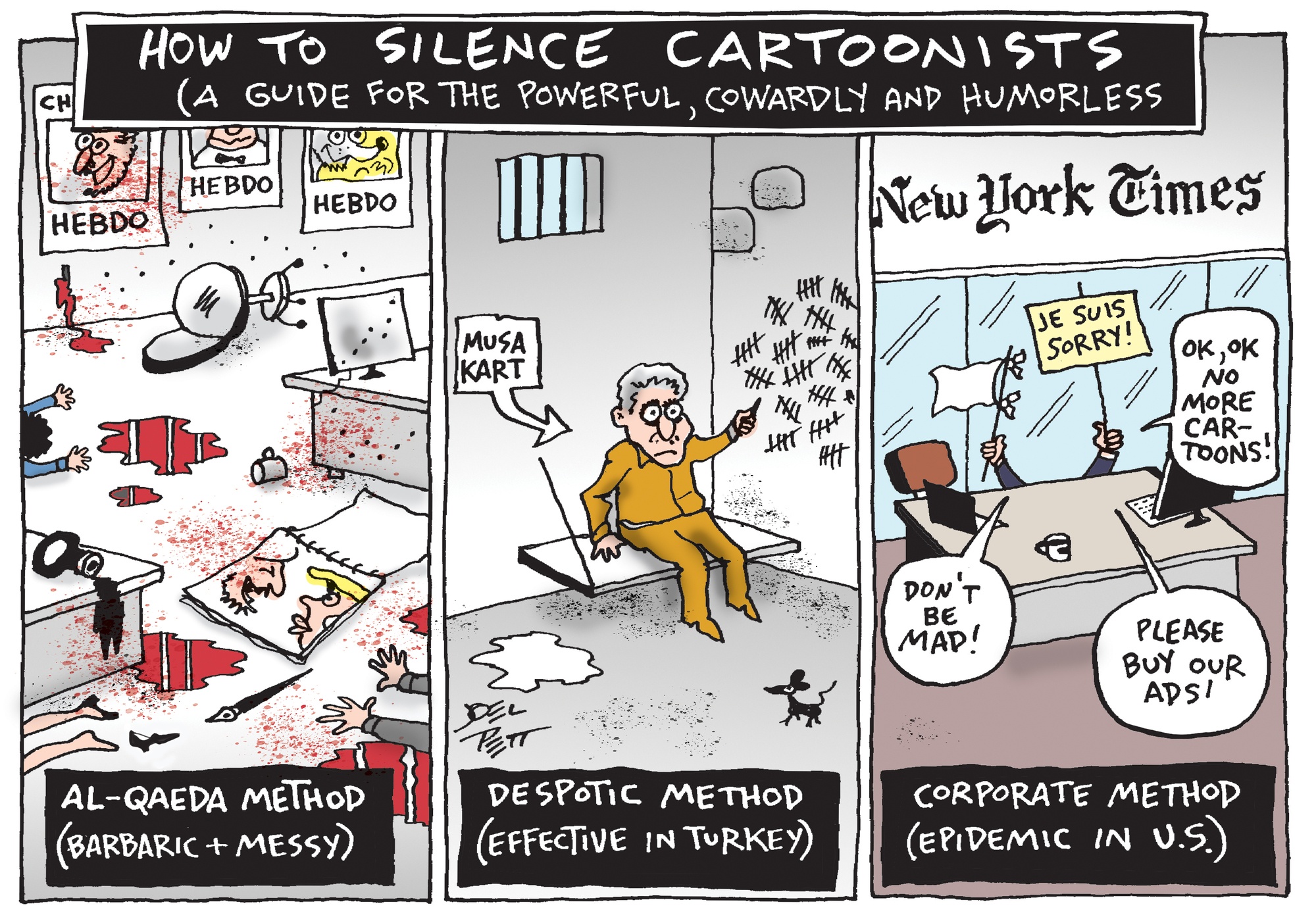Jewish organisation protest outside The New York Times offices over the alleged anti-Semitic cartoon published in the newspaper this month (Getty Images)

“Stop them damn pictures!” So exhorted William Tweed, the corrupt ringleader of New York’s Tammany Hall political machine over 100 years ago, referring to the cartoons of Thomas Nast. Tweed and his cohorts ended up behind bars, and Nast became known as the father of American political cartooning.
Today, though, the New York Times would probably be only too happy to oblige Tweed.
The ‘Gray Lady‘ is looking rather yellow, having dismissed the two in-house cartoonists – Patrick Chapatte and Heng Kim Song – from its international edition, and announcing that it will no longer be publishing editorial cartoons. None. This brings the International New York Times into line with the domestic edition, which already eschews the art form. Tweed would have approved.
It was the result of a dust-up in April over a syndicated cartoon by Portugal’s Antonio Moreira Antunes, showing Israeli Prime Minister Benjamin Netanyahu as Donald Trump’s guide dog. The cartoon was deemed anti-Semitic in some circles, even likened to Nazi-era propaganda, although many cartoonists thought such assertions were exaggerated.
If the cartoon was undeniably problematic, the reaction was uberkill. First, the New York Times apologised, disciplined the INYT editor who had selected it, and ceased doing business with the syndicate which had distributed it. It also published a column by Bret Stephens excoriating the paper while also charging it with a history of antagonism towards Israel.
I can’t speak for Israel, but the New York Times has definitely never been a friend to editorial cartoonists. It hasn’t employed one since Harold MacMillan was PM.
It did until a few years ago, publish a weekly cartoon roundup, but mostly shied away from the edgy stuff. Yes, they sometimes ran mine in that roundup, and I was proud and excited about that large and educated audience when they did. But then, over the howling objections of longtime readers and against the advice of Clark Hoyt, the then-Public Editor (the ombudsman who makes sure journalistic ethics are upheld), they dropped the feature altogether. No explanation was offered, but the decision coincided with a general softening of their Week in Review section.
They might as well have re-christened it ‘Weak in Review’ – you’re as likely to find lifestyle essays about sharing housework within marriage or the etiquette of texting as a serious analysis of, say, the long-term wisdom of leaving the European Union, or the impending climate crisis leading to mass extinctions.
Several factors make this all exceedingly galling. First, as print journalism has struggled over the last decade or two, few US newspapers have felt they had the resources to keep a staff cartoonist. The ranks of full-time practitioners of this venerable art form dwindled from 300 or so in the Seventies to around 100 in 2000 to only a couple of dozen now. So many editors have never even encountered one of our endangered species, let alone worked alongside one of us or been schooled in how to handle the inevitable blowback from our admittedly provocative work. It’s the same at the NYT – even though it has the resources for us. Way to have our backs, paper of record!
The real kicker is that the paper actually won the Pulitzer prize last year for editorial cartoons. This naturally raised a lot of eyebrows. The NYT submitted a long-form series in something approaching a graphic novel format about Syrian refugees settling in the US. It was a collaborative work by writer Jake Halpern and illustrator Michael Sloan.
It didn’t really fit the editorial cartoon category, but was nevertheless a terrific and compelling piece of journalism. Most of us hoped that the award might reawaken the paper to the possibilities of editorial cartoons. It was not to be. And yet, in the midst of his explanation of the Chappatte and Heng firings, the paper’s opinion editor James Bennet, couldn’t resist crowing about the prize.
Our statement in response to ending daily political cartoons in the international edition of The New York Times. pic.twitter.com/FcagTxEZJ9
— NYTimes Communications (@NYTimesPR) June 10, 2019
The New York Times’s institutional objection to the art form has long been a mystery to cartoonists. Could it be that they ultimately fear editorial cartoons? Editors have certainly always been nervous about the capacity of cartoons to instigate controversy.
Most of us remember the 2005 Danish cartoon fiasco, when the Jyllands-Posten paid a nominal sum for, and then published a dozen caricatures of the prophet Muhammed, sparking riots in the Muslim world and a fatwah against the poor freelancers who had taken the bait. Then there was 2015’s bloody massacre at the irreverent French satirical publication, Charlie Hebdo, where 11 journalists were murdered. That’s enough to give any editor pause. It’s also true, as Chappatte posted after his dismissal, that:
“We are in a world where moralistic mobs gather on social media and rise like a storm, falling upon newsrooms in an overwhelming blow.”
But the paper prints plenty of fearless journalism, even in spite of moralistic mobs. Could it be then that our crude scribbles lack the gravitas and nuance of the written word? Is our – admittedly sometimes juvenile – humour beneath them? Or are our leaps of logic and shorthand twists of the knife an affront to the cautious, equivocating approach of corporate managers and editorial page guardians?
Whatever their reasoning, it’s a damn shame about the “damn pictures”. A historic cornerstone of print journalism is dying, casting for a lifeline, and all the paper of record can do is throw it a pair of leaden boots.











Join the discussion
Join like minded readers that support our journalism by becoming a paid subscriber
To join the discussion in the comments, become a paid subscriber.
Join like minded readers that support our journalism, read unlimited articles and enjoy other subscriber-only benefits.
Subscribe